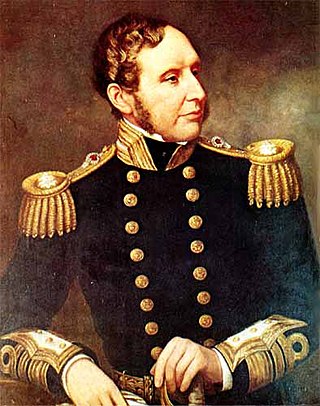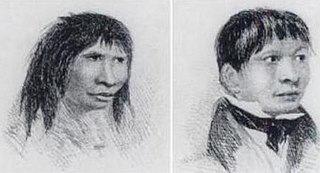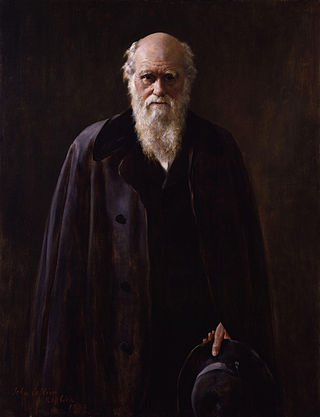
HMS Beagle was a Cherokee-class 10-gun brig-sloop of the Royal Navy, one of more than 100 ships of this class. The vessel, constructed at a cost of £7,803, was launched on 11 May 1820 from the Woolwich Dockyard on the River Thames. Later reports say the ship took part in celebrations of the coronation of King George IV of the United Kingdom, passing through the old London Bridge, and was the first rigged man-of-war afloat upriver of the bridge. There was no immediate need for Beagle, so she "lay in ordinary", moored afloat but without masts or rigging. She was then adapted as a survey barque and took part in three survey expeditions.

Vice-Admiral Robert FitzRoy was an English officer of the Royal Navy and a scientist. He achieved lasting fame as the captain of HMS Beagle during Charles Darwin's famous voyage, FitzRoy's second expedition to Tierra del Fuego and the Southern Cone.

The Voyage of the Beagle is the title most commonly given to the book written by Charles Darwin and published in 1839 as his Journal and Remarks, bringing him considerable fame and respect. This was the third volume of The Narrative of the Voyages of H.M. Ships Adventure and Beagle, the other volumes of which were written or edited by the commanders of the ships. Journal and Remarks covers Darwin's part in the second survey expedition of the ship HMS Beagle. Due to the popularity of Darwin's account, the publisher reissued it later in 1839 as Darwin's Journal of Researches, and the revised second edition published in 1845 used this title. A republication of the book in 1905 introduced the title The Voyage of the "Beagle", by which it is now best known.
Beagle is a breed of dog.

Beagle Channel is a strait in the Tierra del Fuego Archipelago, on the extreme southern tip of South America between Chile and Argentina. The channel separates the larger main island of Isla Grande de Tierra del Fuego from various smaller islands including the islands of Picton, Lennox and Nueva; Navarino; Hoste; Londonderry; and Stewart. The channel's eastern area forms part of the border between Chile and Argentina and the western area is entirely within Chile.

Orundellico, known as "Jeremy Button" or "Jemmy Button", was a member of the Yaghan people from islands around Tierra del Fuego, in modern Chile and Argentina. He was taken to England by Captain FitzRoy in HMS Beagle and became a celebrity there for a period.

Admiral John Lort Stokes was a Royal Navy officer who served onboard HMS Beagle for almost eighteen years.

The Yahgan are a group of indigenous peoples in the Southern Cone. Their traditional territory includes the islands south of Isla Grande de Tierra del Fuego, extending their presence into Cape Horn, making them the world's southernmost human population.
Emma Nora Barlow, Lady Barlow, was a British botanist and geneticist. The granddaughter of the British naturalist Charles Darwin, Barlow began her academic career studying botany at Cambridge under Frederick Blackman, and continued her studies in the new field of genetics under William Bateson from 1904 to 1906. Her primary research focus when working with Bateson was the phenomenon of herostylism within the primrose family. In later life she was one of the first Darwinian scholars, and founder of the Darwin Industry of scholarly research into her grandfather's life and discoveries. She lived to 103.

The second voyage of HMS Beagle, from 27 December 1831 to 2 October 1836, was the second survey expedition of HMS Beagle, under captain Robert FitzRoy, who had taken over command of the ship on its first voyage after the previous captain, Pringle Stokes, committed suicide. FitzRoy had thought of the advantages of having someone onboard who could investigate geology, and sought a naturalist to accompany them as a supernumerary. At the age of 22, the graduate Charles Darwin hoped to see the tropics before becoming a parson, and accepted the opportunity. He was greatly influenced by reading Charles Lyell's Principles of Geology during the voyage. By the end of the expedition, Darwin had made his name as a geologist and fossil collector, and the publication of his journal gave him wide renown as a writer.

The Cherokee class was a class of brig-sloops of the Royal Navy, mounting ten guns. Brig-sloops were sloops-of-war with two masts rather than the three masts of ship sloops. Orders for 115 vessels were placed, including five which were cancelled and six for which the orders were replaced by ones for equivalent steam-powered paddle vessels.

The Structure and Distribution of Coral Reefs, Being the first part of the geology of the voyage of the Beagle, under the command of Capt. Fitzroy, R.N. during the years 1832 to 1836, was published in 1842 as Charles Darwin's first monograph, and set out his theory of the formation of coral reefs and atolls. He conceived of the idea during the voyage of the Beagle while still in South America, before he had seen a coral island, and wrote it out as HMS Beagle crossed the Pacific Ocean, completing his draft by November 1835. At the time there was great scientific interest in the way that coral reefs formed, and Captain Robert FitzRoy's orders from the Admiralty included the investigation of an atoll as an important scientific aim of the voyage. FitzRoy chose to survey the Keeling Islands in the Indian Ocean. The results supported Darwin's theory that the various types of coral reefs and atolls could be explained by uplift and subsidence of vast areas of the Earth's crust under the oceans.

Commemoration of Charles Darwin began with geographical features named after Darwin while he was still on the Beagle survey voyage, continued after his return with the naming of species he had collected, and extended further with his increasing fame. Many geographical features, species and institutions bear his name. Interest in his work has led to scholarship and publications, nicknamed the Darwin Industry, and his life is remembered in fiction, film and TV productions as well as in numerous biographies. Darwin Day has become an annual event, and in 2009 there were worldwide celebrations to mark the bicentenary of Darwin's birth and the 150th anniversary of the publication of On the Origin of Species.

A nautical chronometer made by Thomas Earnshaw (1749–1828), and once part of the equipment of HMS Beagle, the ship that carried Charles Darwin on his voyage around the world, is held in the British Museum. The chronometer was the subject of one episode of the BBC's series A History of the World in 100 Objects.

Geological Observations on South America is a book written by the English naturalist Charles Darwin. The book was published in 1846, and is based on his travels during the second voyage of HMS Beagle, commanded by captain Robert FitzRoy. HMS Beagle arrived in South America to map out the coastlines and islands of the region for the British Navy. On the journey, Darwin collected fossils and plants, and recorded the continent's geological features.

This Thing of Darkness was the debut novel of Harry Thompson, published in 2005 only months before his death in November of that year at the age of 45. Set in the period from 1828 to 1865, it is a historical novel telling the fictionalised biography of Robert FitzRoy, who was given command of HMS Beagle halfway through her first voyage. He subsequently captained her during the vessel’s famous second voyage, on which Charles Darwin travelled as his companion.

The Voyage of Charles Darwin was a 1978 BBC television serial depicting the life of Charles Darwin, focusing largely on his voyage on HMS Beagle. The series encompasses his university days to the 1859 publication of his book On the Origin of Species and his death and is loosely based on Darwin's own letters, diaries, and journals, especially The Voyage of the Beagle and The Autobiography of Charles Darwin. It starred Malcolm Stoddard as Darwin and Andrew Burt as Captain Robert FitzRoy.
Robert FitzRoy (1805–1865) was a Royal Navy vice admiral known for being captain of HMS Beagle during Charles Darwin's voyage.












